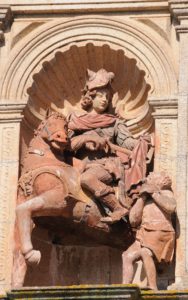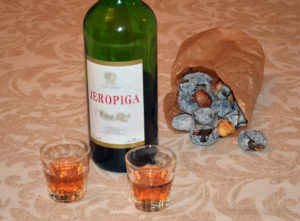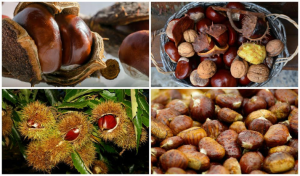“When it was the season aunt Emília used to sell roasted chestnuts outside the bar a little further down the street, on the corner of Rua Morais Soares and Rua dos Heróis de Quionga, got drunk on the proceeds, then could be found flat on her back on the bedroom floor with her skirts hitched up, singing loudly.”
(from: Small memories – José Saramago)
Portugal is a country of saints, giving rise to a good number of public holidays. November 1 is dedicated to All Saint’ Day (Todos-os-Santos) and November 11 to St. Martin (São Martinho) – the period in between is called Magusto, the traditional autumn festival. It is believed that the word ‘magusto’ comes from the Latin word ‘magnus ustus’, meaning ‘big fire’.
 St. Martin’s Day is associated with the maturation of the year’s wine. It is a feast of Celtic roots that celebrates the end of summer and the start of winter.
St. Martin’s Day is associated with the maturation of the year’s wine. It is a feast of Celtic roots that celebrates the end of summer and the start of winter.
The period is also quite popular, because of the usually good weather in this time of the year, called St. Martin’s Summer (Verão de São Martinho), that is tied to the legend of the saint.
Martin of Tours was a Roman soldier in the 4th century – later becoming bishop of Tours, in France – who cut his cape in half with his sword and gave it to a shivering beggar during a cold and rainy day. It is said that at that very moment the sun started shining again for three days.https://lusolobo.com/de-zomer-van
 Groups of friends and families celebrate these warm days in November outdoors and used to gather around a bonfire, where they roasted chestnuts directly in the fire drank água-pé (water-foot), jeropiga, new wine and danced and sang. It was customary for girls to bring the chestnuts and for boys to bring the wine.
Groups of friends and families celebrate these warm days in November outdoors and used to gather around a bonfire, where they roasted chestnuts directly in the fire drank água-pé (water-foot), jeropiga, new wine and danced and sang. It was customary for girls to bring the chestnuts and for boys to bring the wine.
 Água-pé (water-foot) is a light alcoholic beverage made by adding water to crushed grapes – after the juice is pressed out for wine – and letting it ferment for several days. Jeropiga – a sweet and strong fortified wine – is obtained in a similar way by adding brandy(aguardente) to the mash (pomace) of grapes, instead of water.
Água-pé (water-foot) is a light alcoholic beverage made by adding water to crushed grapes – after the juice is pressed out for wine – and letting it ferment for several days. Jeropiga – a sweet and strong fortified wine – is obtained in a similar way by adding brandy(aguardente) to the mash (pomace) of grapes, instead of water.
É dia de São Martinho, It’s St.Martin’s Day,
comem-se castanhas, prova-se o vinho we’ll eat chestnuts and taste the wine
BOM FIM DE SEMANA ENJOY THE WEEKEND

 Als er vanavond tussen 6 en 8 aan de deur wordt gebeld, kunt u daar een kluitje verkleumde kinderen aantreffen – met bleke gezichtjes, zwak beschenen door de flakkerende lichtjes van hun lampionnen – die het onmiddellijk op een zingen zetten. En o wee als er geen snoep in huis is. Dan wordt het hele repertoire opnieuw afgewerkt, maar nu dreigender. Op 11 november wordt in diverse landen Sint Maarten gevierd, maar dat gebeurt niet overal op dezelfde manier.
Als er vanavond tussen 6 en 8 aan de deur wordt gebeld, kunt u daar een kluitje verkleumde kinderen aantreffen – met bleke gezichtjes, zwak beschenen door de flakkerende lichtjes van hun lampionnen – die het onmiddellijk op een zingen zetten. En o wee als er geen snoep in huis is. Dan wordt het hele repertoire opnieuw afgewerkt, maar nu dreigender. Op 11 november wordt in diverse landen Sint Maarten gevierd, maar dat gebeurt niet overal op dezelfde manier. Sint Martinus
Sint Martinus